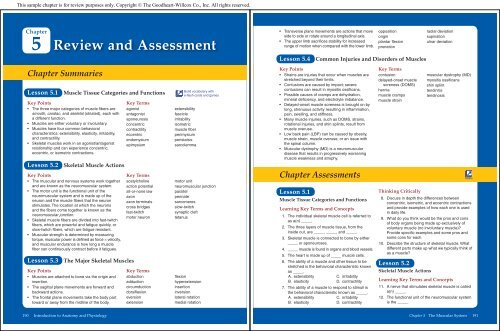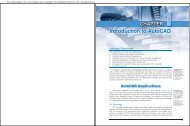You also want an ePaper? Increase the reach of your titles
YUMPU automatically turns print PDFs into web optimized ePapers that Google loves.
This sample chapter is for review purposes only. Copyright © The <strong>Goodheart</strong>-<strong>Willcox</strong> Co., Inc. All rights reserved.<br />
5<br />
<strong>Chapter</strong><br />
Review and Assessment<br />
<strong>Chapter</strong> Summaries<br />
Lesson 5.1 Muscle Tissue Categories and Functions<br />
Key Points<br />
• The three major categories of muscle fi bers are<br />
smooth, cardiac, and skeletal (striated), each with<br />
a different function.<br />
• Muscles are either voluntary or involuntary.<br />
• Muscles have four common behavioral<br />
characteristics: extensibility, elasticity, irritability,<br />
and contractility.<br />
• Skeletal muscles work in an agonist/antagonist<br />
relationship and can experience concentric,<br />
eccentric, or isometric contractions.<br />
Lesson 5.2 Skeletal Muscle Actions<br />
Key Points<br />
• The muscular and nervous systems work together<br />
and are known as the neuromuscular system.<br />
• The motor unit is the functional unit of the<br />
neuromuscular system and is made up of the<br />
neuron and the muscle fi bers that the neuron<br />
stimulates. The location at which the neurons<br />
and the fi bers come together is known as the<br />
neuromuscular junction.<br />
• Skeletal muscle fi bers are divided into fast-twitch<br />
fi bers, which are powerful and fatigue quickly, or<br />
slow-twitch fi bers, which are fatigue resistant.<br />
• Muscular strength is determined by measuring<br />
torque, muscular power is defi ned as force × velocity,<br />
and muscular endurance is how long a muscle<br />
fi ber can continuously contract before it fatigues.<br />
Lesson 5.3 The Major Skeletal Muscles<br />
Key Points<br />
• Muscles are attached to bone via the origin and<br />
insertion.<br />
• The sagittal plane movements are forward and<br />
backward actions.<br />
• The frontal plane movements take the body part<br />
toward or away from the midline of the body.<br />
190 Introduction to Anatomy and Physiology<br />
Key Terms<br />
agonist<br />
antagonist<br />
aponeurosis<br />
concentric<br />
contractility<br />
eccentric<br />
endomysium<br />
epimysium<br />
Key Terms<br />
acetylcholine<br />
action potential<br />
all-or-none law<br />
axon<br />
axon terminals<br />
cross bridges<br />
fast-twitch<br />
motor neuron<br />
Key Terms<br />
abduction<br />
adduction<br />
circumduction<br />
dorsifl exion<br />
eversion<br />
extension<br />
Build vocabulary with<br />
e-fl ash cards and games<br />
extensibility<br />
fascicle<br />
irritability<br />
isometric<br />
muscle fi ber<br />
perimysium<br />
peristalsis<br />
sarcolemma<br />
motor unit<br />
neuromuscular junction<br />
parallel<br />
pennate<br />
sarcomeres<br />
slow-twitch<br />
synaptic cleft<br />
tetanus<br />
fl exion<br />
hyperextension<br />
insertion<br />
inversion<br />
lateral rotation<br />
medial rotation<br />
• Transverse plane movements are actions that move<br />
side to side or rotate around a longitudinal axis.<br />
• The upper limb sacrifi ces stability for increased<br />
range of motion when compared with the lower limb.<br />
opposition<br />
origin<br />
plantar fl exion<br />
pronation<br />
Lesson 5.4 Common Injuries and Disorders of Muscles<br />
Key Points<br />
• Strains are injuries that occur when muscles are<br />
stretched beyond their limits.<br />
• Contusions are caused by impact; severe<br />
contusions can result in myositis ossifi cans.<br />
• Possible causes of cramps are dehydration,<br />
mineral defi ciency, and electrolyte imbalance.<br />
• Delayed-onset muscle soreness is brought on by<br />
long, strenuous activity resulting in infl ammation,<br />
pain, swelling, and stiffness.<br />
• Many muscle injuries, such as DOMS, strains,<br />
rotational injuries, and shin splints, result from<br />
muscle overuse.<br />
• Low back pain (LBP) can be caused by obesity,<br />
muscle strain, muscle overuse, or an issue with<br />
the spinal column.<br />
• Muscular dystrophy (MD) is a neuromuscular<br />
disease that results in progressively worsening<br />
muscle weakness and atrophy.<br />
Lesson 5.1<br />
Key Terms<br />
contusion<br />
delayed-onset muscle<br />
soreness (DOMS)<br />
hernia<br />
muscle cramps<br />
muscle strain<br />
radial deviation<br />
supination<br />
ulnar deviation<br />
muscular dystrophy (MD)<br />
myositis ossifi cans<br />
shin splint<br />
tendinitis<br />
tendinosis<br />
<strong>Chapter</strong> Assessments Assess<br />
Muscle Tissue Categories and Functions<br />
Thinking Critically<br />
8. Discuss in depth the differences between<br />
concentric, isometric, and eccentric contractions<br />
Learning Key Terms and Concepts<br />
and provide examples of how each one is used<br />
in daily life.<br />
1. The individual skeletal muscle cell is referred to<br />
as a(n) _____.<br />
2. The three layers of muscle tissue, from the<br />
9. What do you think would be the pros and cons<br />
of body organs being made up exclusively of<br />
voluntary muscle (no involuntary muscle)?<br />
inside out, are _____, _____, and _____.<br />
Provide specifi c examples and some pros and<br />
3. Skeletal muscle is connected to bone by either some cons for each.<br />
_____ or aponeuroses.<br />
10. Describe the structure of skeletal muscle. What<br />
4. _____ muscle is found in organs and blood vessels. different parts make up what we typically think of<br />
5. The heart is made up of _____ muscle cells.<br />
as a muscle?<br />
6. The ability of a muscle and other tissue to be<br />
stretched is the behavioral characteristic known<br />
as _____.<br />
Lesson 5.2<br />
Skeletal Muscle Actions<br />
A. extensibility<br />
B. elasticity<br />
C. irritability<br />
D. contractility Learning Key Terms and Concepts<br />
7. The ability of a muscle to respond to stimuli is 11. A nerve that stimulates skeletal muscle is called<br />
the behavioral characteristic known as _____. a(n) _____.<br />
A. extensibility<br />
C. irritability<br />
12. The functional unit of the neuromuscular system<br />
B. elasticity<br />
D. contractility<br />
is the _____.<br />
<strong>Chapter</strong> 5 The Muscular System 191

















